Calculator for com. Kosygin
Probably at all times, people gave each other gifts. It would seem that the word “gift” is one, but has different meanings and meanings depending on the circumstances. Compare, for example, a gift from parents to a child, a gift from a child to parents (especially when the child saved money from his pocket money), a gift from management to subordinates (such as corporate parties for the New Year), a gift from subordinates to the director, etc.

This calculator is a pre-production sample of the “B3-18 electronics” microcalculator. It was made in 1975 and presented personally to Alexei Nikolayevich Kosygin, Chairman of the USSR Council of Ministers. You can read about Kosygin, for example, on Wikipedia .

')
On the box you can see the inscription made by the technology "metal photo".
If we consider only calculators, then I know several models that were presented to delegates of various party congresses. For example, the first scientific calculator of the production of Svetlana NPO " Electronics C3-15 " was presented to delegates of the 25th CPSU Congress in 1976. On my site you can even see instructions executed in various languages, just about this. Or a well-known similar story with a micro-calculator - a notebook " Electronics MK-87 " on a 16-bit microprocessor. They generally did something in the region of 7,000 pieces, presented to delegates, were no longer produced, and they did not go on sale.
But back in 1975 year. And before telling about this particular calculator, I would like to walk a little on other models of calculating machines produced for that period. In general, pocket calculators in the country in those years were very, very few. Just a few models. I remembered the excitement at the electronics store in Leningrad in 1976, when they began selling the first mass pocket calculators (I consider hundreds of thousands of pieces to be massive) " B3-09M Electronics " and " B3-14M Electronics " with simple arithmetic actions, without a register of memory and with the price of 90 rubles.
In those years, calculators were bought mainly by enterprises. And these were great files, executed in fine logic, mainly in the K172 series. This is the famous Iskra series : the Iskra 110 accounting models - the Iskra 114 and the Iskra 121 accounting and accounting models - the Iskra 123. The latest model is programmable with 70 program steps. These are calculators on integrated circuits. And before them were made and models on transistors and potential elements of the type "MIR-10". In 1975, for about a year, our first models on four LSI (large integrated circuits) were mass-produced (approximately from 1973-1974). These are Leningrad “Electronics 24-71” and Kiev “Electronics 4-71B” (in both models the numbers are 1971 - the year when they were developed, but a few more years passed before full-fledged serial production).
There were also pocket models - our first pocket calculator “Electronics B3-04” with a glass plate and several chips. And even the first single-chip calculator "Electronics B3-08" (all the same with six chips of strapping along the edges). But these models, although they were produced in thousands of pieces, but according to my information, did not even reach up to ten thousand, and for our country it was very, very small.
In bulk in those years, calculators were imported from abroad - from the GDR and Bulgaria. If you remember the movie “Office Romance” of 1977, the park of calculators is very well shown there.

Novoseltsev has a transistor “Soemtron 220” on the table, and in front of him is the Bulgarian “Elka 50”, already on chips.

And here, in 1975, against the background of these calculating machines, a truly pocket model appeared, later called the “Electronics B3-18” . And engineering. And really on one chip (in a similar, but more sophisticated "Electronics C3-15" there were seven of them). How such a beckoning is not to introduce the minister himself!
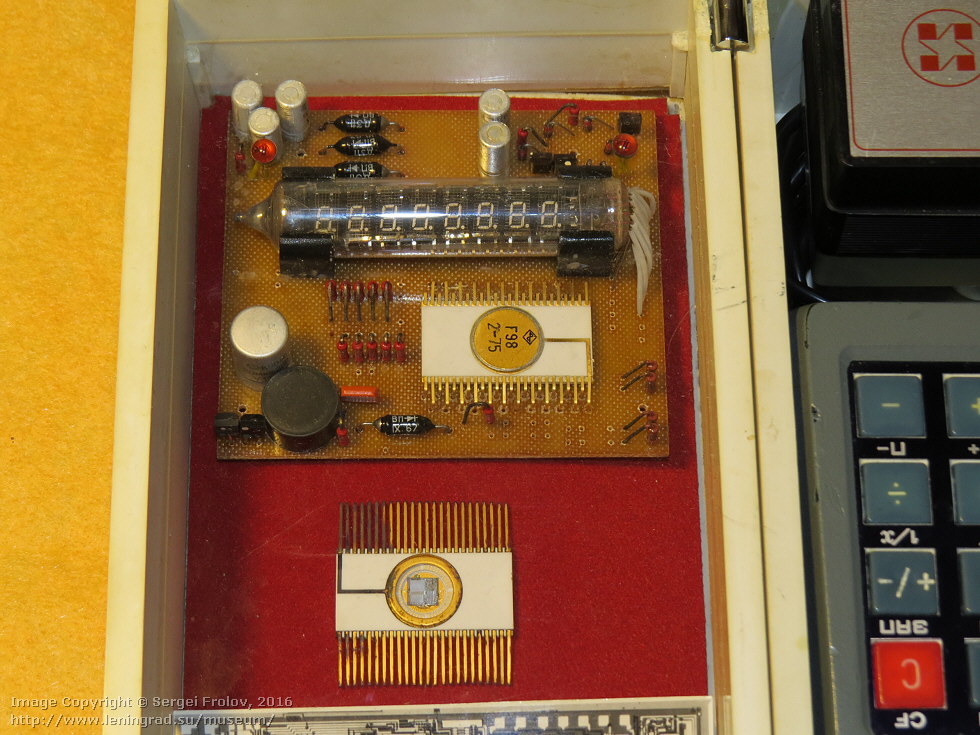
It really was a significant step forward in the technology of our microelectronics. Apart from the calculator, you can see a printed circuit board, where the entire calculator electronic filling is shown, and a chip separately with the cover removed and the crystal shown.
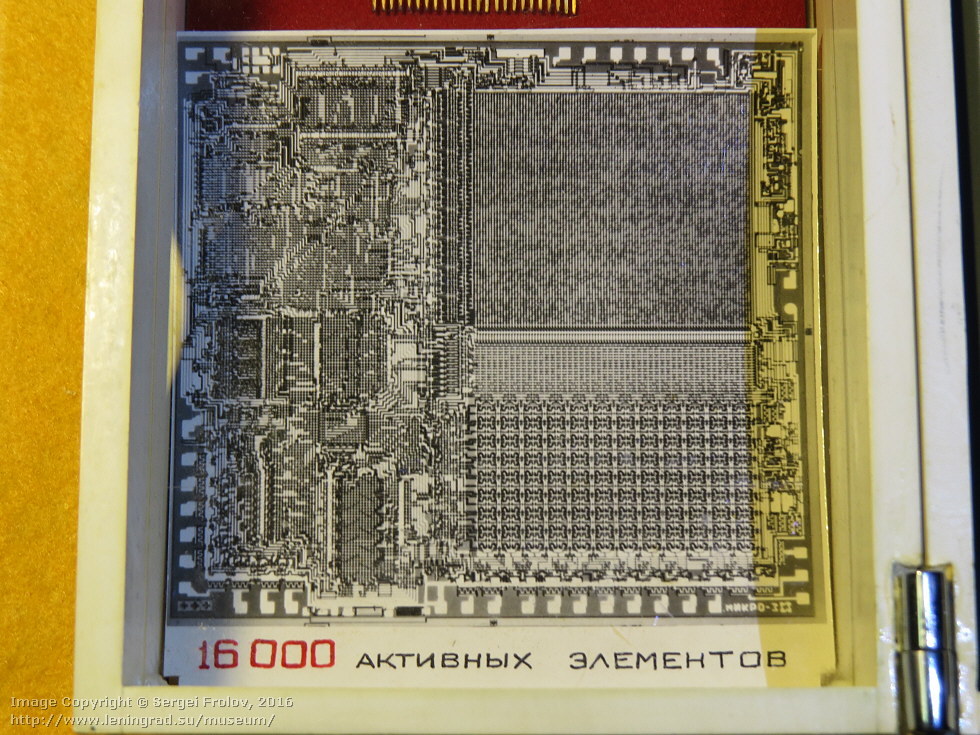
There is even a picture of the topology. 16,000 transistors in a single chip. Compared with 6000 transistors in "Electronics B3-04" (there this number of "6000 transistors" flaunts on the body as an advertising slogan). If you look closely at this photo, then in the lower right corner is the inscription "Micro-3". As if hinting at the fact that this is the third development. I know that in B3-08 there was a chip labeled "Micro-2". "Micro-3" then finalized to "Micro-3M."
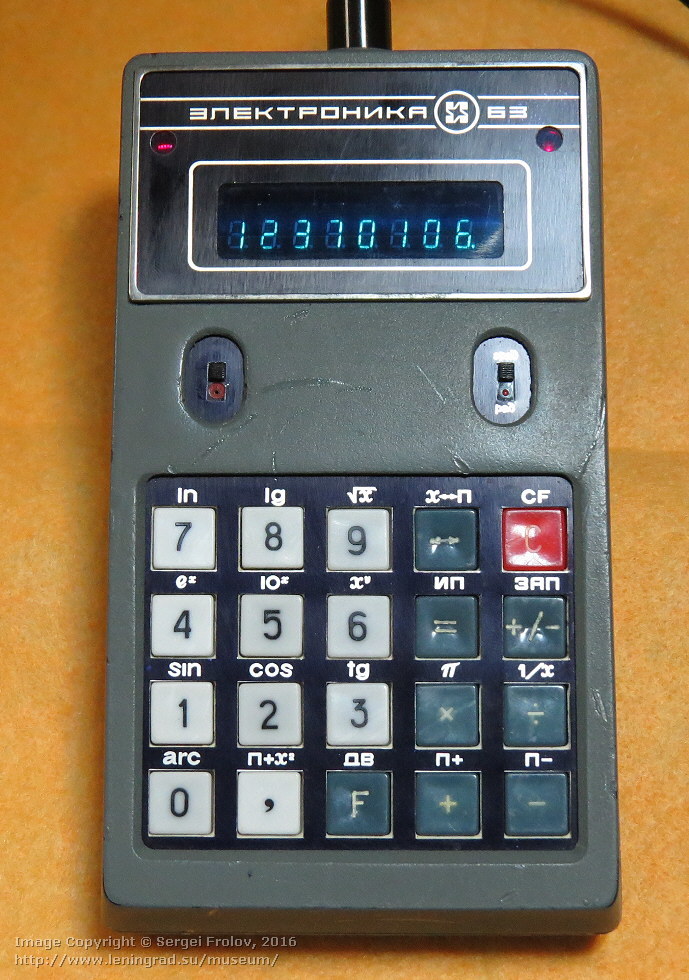
By the way, the calculator, despite the fact that it is over forty years old, is in working condition. It is interesting to note that the indicator stands with a blue light filter. On mass models then put green. The calculator has eight digits, with one memory register. No floating point. But there is an entire basic set of trigonometric and logarithmic functions.

It is also interesting that the sign of the negative number “minus” and the sign of overflow are displayed on separate LEDs. In the serial "Electronics B3-18", these icons will habitually fit into the indicator with the ninth official discharge.
And also look at the LED that forms the minus sign. I have not seen such LEDs before.

On the back of the nameplate even stands the year 1974, it is clear the year the development began. The chips themselves are traded in February 1975.
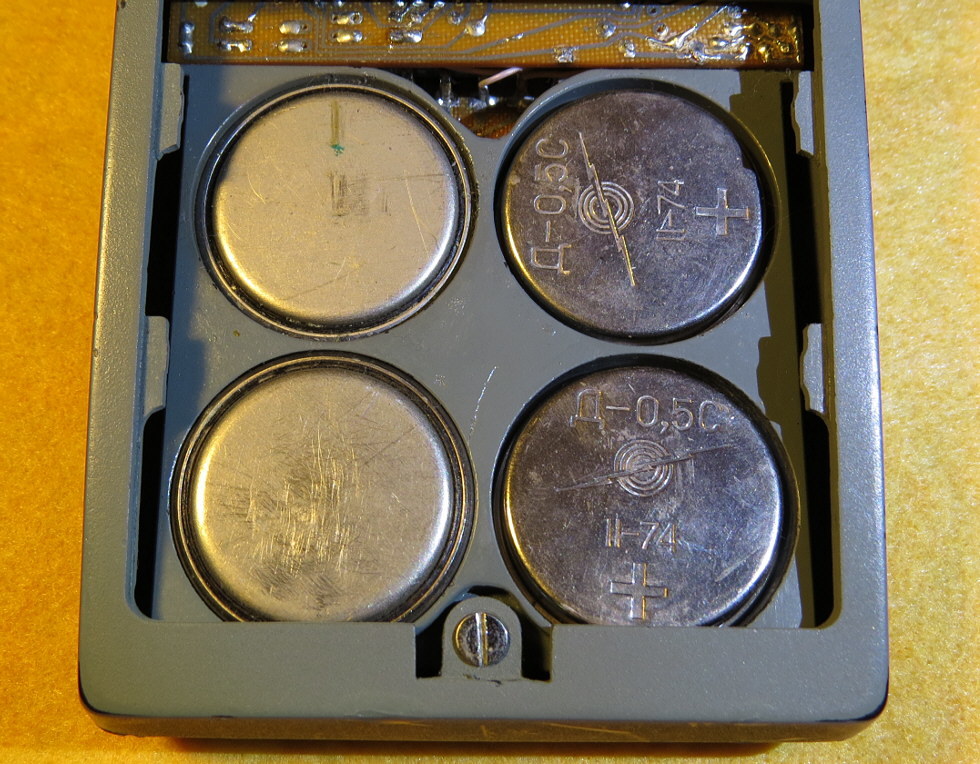
This is a standalone model. It can work both from the mains through an adapter / charge and from D0.55 type batteries.

But the real fee, which is in the calculator. Unlike the board, attached separately, the microcircuit in it is a lid down. This is very unusual and it is not clear why. It became even more interesting when I looked at the microcircuit with the lid open in a microscope and compared it with the microcircuit that I took from the K145IP7 serial chip from B3-18 Electronics (photo from the Portable Retro Radio).

It turned out that in this chip the crystal is made like a mirror! That is, you can take a topology, take a mirror image, and this will work. Because the chip is in the calculator lid down. Then the topology in the serial chips will be “as it should,” but I did not understand why they mirrored it.
What happened in the end. This model went into series in the beginning of 1976 under the name "Electronics B3-18". Chip K145IP7 with minor modifications (KR145IP7, K145IP12) was produced right up to the 1990s and stood in several models of calculators: B3-18, B3-18A, B3-18M, MK-18M, B3-37, MK-37, MK- 37A. Calculators performed the same functions, but had different design and types of indicators.
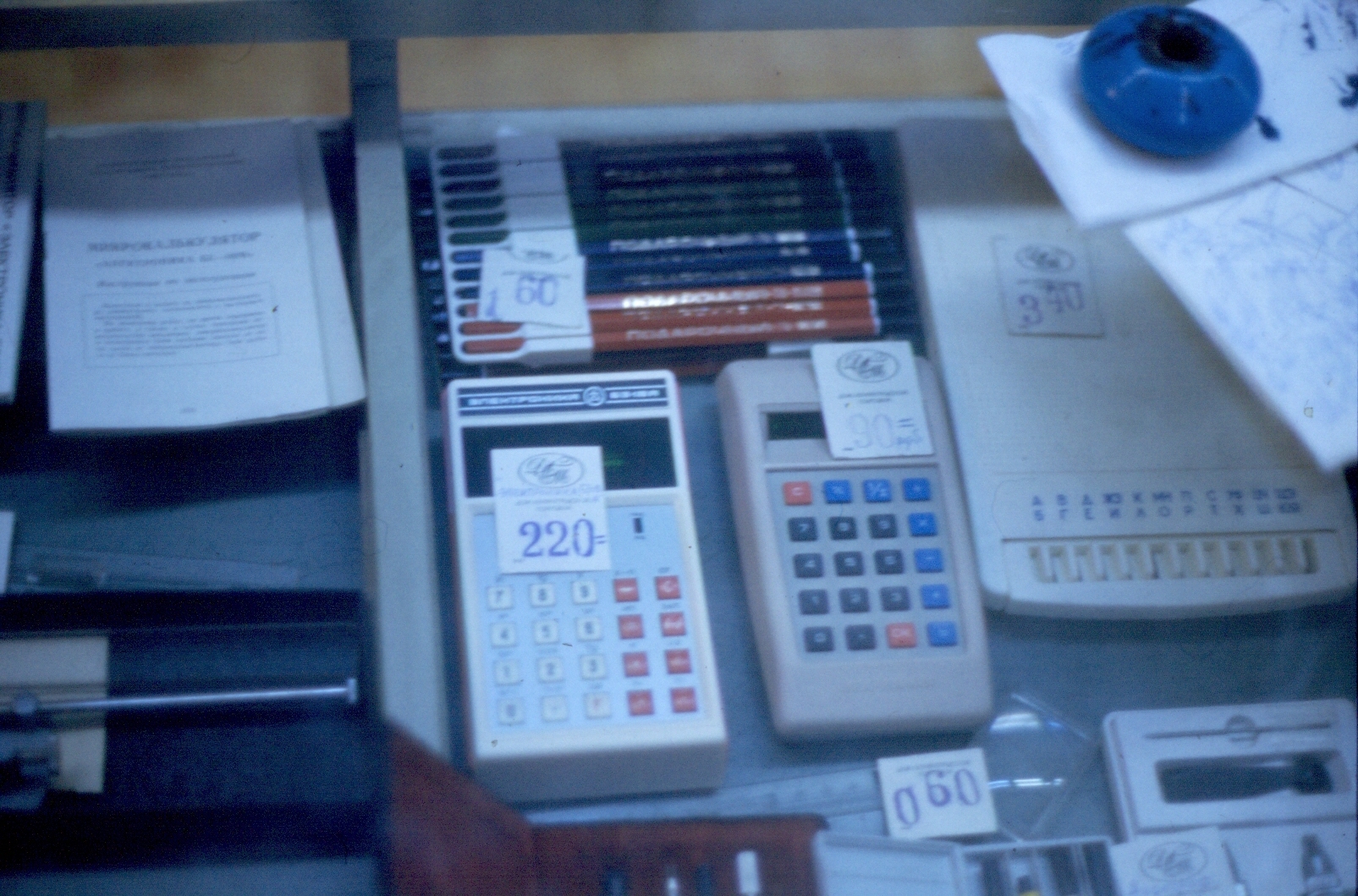
If the first model “Electronics B3-18A” cost 220 rubles (in terms of the average engineer’s salaries, it can be compared to the price of the last iPhone, with approximately the same level of steepness for that period), then the last one is around 43 rubles. The microcircuit and calculators produced several factories and, as a result, greatly helped to saturate the market with electronic assistants.
Well, then - went, gone. As I said, in 1976, the simple B3-09M Electronics and B3-14M Electronics went massively, in 1977 the first pocket-based programmable calculator B3-21 Electronics appeared, then more pocket models appeared on the LCD, and so on.
Here is a calculator for Comrade. Kosygin, and such he turned the story.
This calculator is a pre-production sample of the “B3-18 electronics” microcalculator. It was made in 1975 and presented personally to Alexei Nikolayevich Kosygin, Chairman of the USSR Council of Ministers. You can read about Kosygin, for example, on Wikipedia .
')
On the box you can see the inscription made by the technology "metal photo".
If we consider only calculators, then I know several models that were presented to delegates of various party congresses. For example, the first scientific calculator of the production of Svetlana NPO " Electronics C3-15 " was presented to delegates of the 25th CPSU Congress in 1976. On my site you can even see instructions executed in various languages, just about this. Or a well-known similar story with a micro-calculator - a notebook " Electronics MK-87 " on a 16-bit microprocessor. They generally did something in the region of 7,000 pieces, presented to delegates, were no longer produced, and they did not go on sale.
But back in 1975 year. And before telling about this particular calculator, I would like to walk a little on other models of calculating machines produced for that period. In general, pocket calculators in the country in those years were very, very few. Just a few models. I remembered the excitement at the electronics store in Leningrad in 1976, when they began selling the first mass pocket calculators (I consider hundreds of thousands of pieces to be massive) " B3-09M Electronics " and " B3-14M Electronics " with simple arithmetic actions, without a register of memory and with the price of 90 rubles.
In those years, calculators were bought mainly by enterprises. And these were great files, executed in fine logic, mainly in the K172 series. This is the famous Iskra series : the Iskra 110 accounting models - the Iskra 114 and the Iskra 121 accounting and accounting models - the Iskra 123. The latest model is programmable with 70 program steps. These are calculators on integrated circuits. And before them were made and models on transistors and potential elements of the type "MIR-10". In 1975, for about a year, our first models on four LSI (large integrated circuits) were mass-produced (approximately from 1973-1974). These are Leningrad “Electronics 24-71” and Kiev “Electronics 4-71B” (in both models the numbers are 1971 - the year when they were developed, but a few more years passed before full-fledged serial production).
There were also pocket models - our first pocket calculator “Electronics B3-04” with a glass plate and several chips. And even the first single-chip calculator "Electronics B3-08" (all the same with six chips of strapping along the edges). But these models, although they were produced in thousands of pieces, but according to my information, did not even reach up to ten thousand, and for our country it was very, very small.
In bulk in those years, calculators were imported from abroad - from the GDR and Bulgaria. If you remember the movie “Office Romance” of 1977, the park of calculators is very well shown there.

Novoseltsev has a transistor “Soemtron 220” on the table, and in front of him is the Bulgarian “Elka 50”, already on chips.
And here, in 1975, against the background of these calculating machines, a truly pocket model appeared, later called the “Electronics B3-18” . And engineering. And really on one chip (in a similar, but more sophisticated "Electronics C3-15" there were seven of them). How such a beckoning is not to introduce the minister himself!
It really was a significant step forward in the technology of our microelectronics. Apart from the calculator, you can see a printed circuit board, where the entire calculator electronic filling is shown, and a chip separately with the cover removed and the crystal shown.
There is even a picture of the topology. 16,000 transistors in a single chip. Compared with 6000 transistors in "Electronics B3-04" (there this number of "6000 transistors" flaunts on the body as an advertising slogan). If you look closely at this photo, then in the lower right corner is the inscription "Micro-3". As if hinting at the fact that this is the third development. I know that in B3-08 there was a chip labeled "Micro-2". "Micro-3" then finalized to "Micro-3M."
By the way, the calculator, despite the fact that it is over forty years old, is in working condition. It is interesting to note that the indicator stands with a blue light filter. On mass models then put green. The calculator has eight digits, with one memory register. No floating point. But there is an entire basic set of trigonometric and logarithmic functions.
It is also interesting that the sign of the negative number “minus” and the sign of overflow are displayed on separate LEDs. In the serial "Electronics B3-18", these icons will habitually fit into the indicator with the ninth official discharge.
And also look at the LED that forms the minus sign. I have not seen such LEDs before.
On the back of the nameplate even stands the year 1974, it is clear the year the development began. The chips themselves are traded in February 1975.
This is a standalone model. It can work both from the mains through an adapter / charge and from D0.55 type batteries.
But the real fee, which is in the calculator. Unlike the board, attached separately, the microcircuit in it is a lid down. This is very unusual and it is not clear why. It became even more interesting when I looked at the microcircuit with the lid open in a microscope and compared it with the microcircuit that I took from the K145IP7 serial chip from B3-18 Electronics (photo from the Portable Retro Radio).

It turned out that in this chip the crystal is made like a mirror! That is, you can take a topology, take a mirror image, and this will work. Because the chip is in the calculator lid down. Then the topology in the serial chips will be “as it should,” but I did not understand why they mirrored it.
What happened in the end. This model went into series in the beginning of 1976 under the name "Electronics B3-18". Chip K145IP7 with minor modifications (KR145IP7, K145IP12) was produced right up to the 1990s and stood in several models of calculators: B3-18, B3-18A, B3-18M, MK-18M, B3-37, MK-37, MK- 37A. Calculators performed the same functions, but had different design and types of indicators.

If the first model “Electronics B3-18A” cost 220 rubles (in terms of the average engineer’s salaries, it can be compared to the price of the last iPhone, with approximately the same level of steepness for that period), then the last one is around 43 rubles. The microcircuit and calculators produced several factories and, as a result, greatly helped to saturate the market with electronic assistants.
Well, then - went, gone. As I said, in 1976, the simple B3-09M Electronics and B3-14M Electronics went massively, in 1977 the first pocket-based programmable calculator B3-21 Electronics appeared, then more pocket models appeared on the LCD, and so on.
Here is a calculator for Comrade. Kosygin, and such he turned the story.
Source: https://habr.com/ru/post/399263/
All Articles